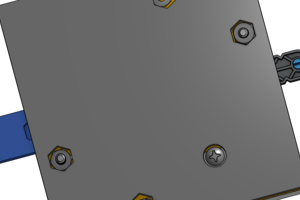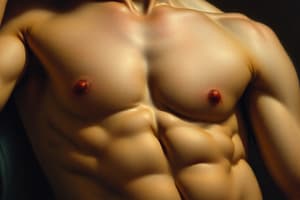Podcast
Questions and Answers
What are androgens primarily known as?
What are androgens primarily known as?
- Female sex hormones
- Steroidal hormones
- Male sex hormones (correct)
- Growth hormones
Which is the primary androgen found in the blood?
Which is the primary androgen found in the blood?
Testosterone
Which of the following disorders are major disorders affecting the male reproductive system? (Select all that apply)
Which of the following disorders are major disorders affecting the male reproductive system? (Select all that apply)
- Erectile dysfunction (correct)
- Prostate cancer (correct)
- Aging-related androgen insufficiency (correct)
- Ovarian cancer
What substance is secreted by the testis?
What substance is secreted by the testis?
Who administered an extract of testosterone in 1889 and reported increased vigor?
Who administered an extract of testosterone in 1889 and reported increased vigor?
Testosterone has a ________ group at C3 and a hydroxyl at C17.
Testosterone has a ________ group at C3 and a hydroxyl at C17.
What is synthesized through the action of testosterone?
What is synthesized through the action of testosterone?
Which pathway converts testosterone to dihydrotestosterone?
Which pathway converts testosterone to dihydrotestosterone?
Testosterone can only be administered orally.
Testosterone can only be administered orally.
What is the effect of testosterone on the larynx?
What is the effect of testosterone on the larynx?
Flashcards are hidden until you start studying
Study Notes
Androgens
- Male sex hormones
- Belong to C19 steroids with a ketone at C3 position and a hydroxyl at C17 position
- Testosterone is the primary androgen in blood
- 5α-dihydrotestosterone is an active metabolite
- All steroid classes are present in both sexes but testosterone levels are higher in males
Androgenic Activity
- Development of male characteristics
- Secreted by the testis and adrenal cortex
Anabolic Activity
- Growth of muscle and bone
- Secreted by the testis and adrenal cortex
Disorders Affecting the Male Reproductive System
- Aging-related androgen insufficiency
- Prostate cancer
- Testicular cancer
- Benign prostatic hyperplasia (BPH)
- Erectile dysfunction (ED)
- Most disorders are caused by testosterone deficiency or excess
Discovery
- French physiologist Charles Brown-Séquard administered an extract to himself and reported increased vigor and work capacity in 1889
- Pézard showed in 1911 that testicular extracts increase comb growth in capons
- Butenandt isolated 15mg of crystalline androsterone from 15,000 L of human male urine in 1931
- Butenandt and Dannenberg isolated crystalline dehydroepiandrosterone, which has weak androgenic activity in 1934
- Testosterone was isolated from bull testes in 1935 - it is 6-10 times more active than previous compounds
- Many steroids with androgenic activity have been synthesized
Testosterone
- It is a C-19 Androstane nucleus steroid
- Known as androgen
- Contains a Delta 4-3Keto group
- There is no side chain at the 17th position
- Contains a beta-hydroxyl group at the 17th position
Biosynthesis
- Cholesterol is the precursor
- Conversion of cholesterol to pregnenolone in the mitochondria
- Pregnenolone is converted to progesterone
- Progesterone is converted to 17α-hydroxyprogesterone
- 17α-hydroxyprogesterone is converted to androstenedione
- Androstenedione is converted to testosterone
Physiology
- Testosterone and its metabolites have effects on the body
- Testosterone is essential for the differentiation and growth of accessory reproductive organs
- It controls male sexual behavior
- It maintains male secondary characteristics (muscle, bone, larynx, hair)
- Low testosterone stimulates the release of GnRH
- GnRH increases LH production in the pituitary gland
- LH increases testosterone production in Leydig cells
- FSH stimulates Sertoli cells to control spermatogenesis and testicular development
Effects of Testosterone - Androgenic
- Growth of the penis and scrotum in boys
- Growth of pubic, axillary, and beard hair
- Laryngeal growth causing a lower pitched voice in boys
- Stimulation and maintenance of sexual function in men
- Sebum secretion
- Reduction of hormone binding and increase liver synthesis of clotting factors, triglycerides, and lipase
- Growth of the prostate and stimulation of erythropoietin production
Effects of Testosterone - Anabolic
- Increase in muscle mass
- Increase in skeletal growth
- Increase in protein synthesis
- Retention of nitrogen by increasing protein synthesis and muscle mass and decreasing protein catabolism
Pharmacokinetics
- Orally administered testosterone is rapidly converted to inactive metabolites, leaving only about one sixth of the dose in active form
- Parentral administration allows for prolonged absorption and increased activity of propionate ester form
- Androsterone and etiocholanolone are the major metabolic products excreted in urine as conjugates with glucuronic acid and sulfate
Metabolism
- Testosterone is metabolized in target tissues and the liver
- 5α-reductase converts testosterone to DHT in the prostate gland, skin and liver
- Aromatase converts testosterone to estradiol in adipose tissue
- The liver inactivates testosterone through reduction and oxidation followed by glucuronidation and renal excretion
Studying That Suits You
Use AI to generate personalized quizzes and flashcards to suit your learning preferences.




